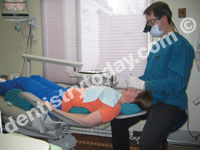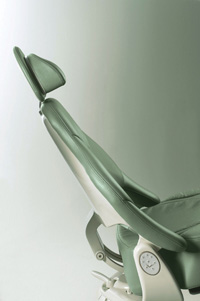My previous articles on dental ergonomics published in Dentistry Today (September 2008, April 2009, and July 2009; these can be viewed at dentistrytoday.com) have focused on equipment in the operatory that can have a significant impact on the dentist’s musculoskeletal health. Along these lines, the obvious products that immediately come to most doctors’ minds are the operator stool, loupes, patient chair, and delivery system. However, there is a plethora of smaller, lesser-known products on the market today that can have just as positive an impact on your health as the more commonplace equipment. In this article on dental ergonomic products, we will delve into the smaller world of interventions. We’ll explore products with features that may, at first glance, appear simply interesting or unusual, but whose features offer powerful ergonomic benefits to help you work more comfortably, increase productivity, and extend your career.
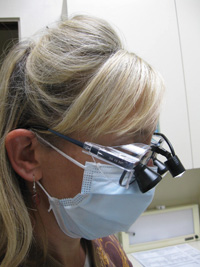 |
|---|
| Figure 1. The Feather Light (Ultralight Optics) is the lightest weight and smallest headlight on the market and delivers 39,000 lux. |
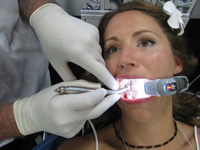 |
|
Figure 2. The Isolite dryfield illuminator (Isolite) offers multiple ergonomic benefits by combining suction, illumination, and rubber dam in one product. |
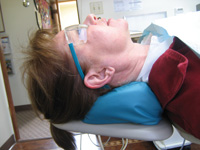 |
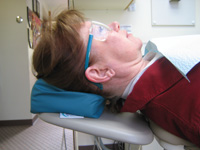 |
|
Figures 3a and 3b. The contoured shape of the dental headrest from Crescent Products allows for proper patient positioning for upper (3a; left) and lower (3b; right) arches. |
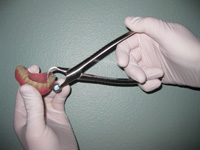 |
| Figure 4. The Physics Forceps (GoldenMisch) reduce 2 primary risk factors that lead to carpal tunnel syndrome. |
LIGHTWEIGHT HEADLIGHTS
The most recent studies on overhead lighting recommend that the light closely parallel the operator’s line of sight to within 15° in order to prevent shadowing.1,2 This means that the light will need to be placed behind and slightly to one side of your head. However, many lighting arms do not extend far enough for this positioning, and thus cast shadows over parts of the oral cavity.
RUBBER DAM AND LIP/CHEEK RETRACTORS
The ergonomic benefits of rubber dams and cheek retractors are often overlooked. The following excerpt is from the author’s book, Practice Dentistry Pain-Free: Evidence-based Strategies to Prevent Pain and Extend Your Career:
DRYFIELD ILLUMINATORS
One of the most innovative ergonomic products to appear on the scene combines the features of suction, illumination, and isolation into one convenient product. The Isolite dryfield illuminator (Isolite Systems) allows the practitioner to isolate quadrants of the mouth, retracting the tongue and cheek while propping the patient’s mouth open (Figure 2). Hands-free evacuation of debris and fluid occurs continuously while lighting is provided from within the mouth for shadow-free illumination. Additional ergonomic benefits include reducing the need to constantly reach overhead to readjust the light, it has no headlight, it frees up the assistant for other duties (since it retracts and suctions), it is easier and quicker to set up than a rubber dam, and there are no clamps to fall off. Productivity may therefore be positively impacted.
PATIENT POSITIONING AIDS
For optimal access and viewing, the occlusal plane of the upper arch should be angled backward about 20° (or so) from the vertical plane. Likewise, when treating the lower arch, the occlusal plane of the mandibular arch should be between 0° to 30° raised in relation to the horizontal plane.2 Getting the patient into the proper position to preserve a safe working posture is often a challenge. A dental headrest cushion that is contoured to position for both upper and lower arches helps position the patient for better viewing (Figures 3a and 3b). Crescent Products also makes a larger Osteo Pillow for geriatric patients whose kyphotic head posture can be a challenge to support. Caution: Some dogbone-type headrests are too large for the patient’s cervical curve and actually push the head and chin forward and down. This is just the opposite of what you would want for viewing the upper arch.
GLOVES
Ambidextrous gloves may cause carpal tunnel syndrome-type pain, especially at the base of the thumb on the palmar side of the hand. Ambidextrous gloves are molded with the hand in a flat position and were originally designed for short medical exams.4 Then, dentists began using them for extended periods of time, finding that prolonged pulling of the glove into a working position caused strain in the thenar eminence, often resulting in pain. Fitted gloves are molded with the hand in a dynamic working position, and result in one third less force exertion than ambi-dextrous gloves.4
COMBINING TECHNOLOGIES: CARESCOPE
Traditional intraoral cameras often require wrist-twisting for proper placement and can be awkward to manipulate the focus. Combining the technology of an endoscope, lighted mirror, and an intraoral camera on one handpiece with a 360° swivel, the CareScope (CaringQuest) offers several ergonomic benefits during diagnosis. A magnified image is viewed on an LCD screen that allows the operator to sit upright. Meant to be held in the dentist’s or hygienist’s hand instead of a dental mirror, there is no need to interrupt treatment and get a camera. Offering 10x the magnification of loupes (5x to 40x), the CareScope may improve productivity with the im-proved visual acuity, and discovery of previously unnoticed caries and encourage better case acceptance through patient education on the LCD screen. When used in conjunction with the Isolite dryfield illuminator, the CareScope may also be used for restorative dentistry.
ATRAUMATIC EXTRACTION FORCEPS
Undoubtedly, extractions pose one of the highest ergonomic risks of the hand and wrist for general dentists. Combining a forceful grip with twisting, nonneutral postures of the wrist are 2 of the most potent risk factors for carpal tunnel syndrome.5,6 A new extractor tool (Physics Forceps [GoldenMisch]) replaces strong grip force with leverage, dramatically decreasing muscle exertion and carpal tunnel compression (Figure 4). Properly placing the Physics Forceps for optimal leverage, the dentist then applies a light, constant, slow, rotational force on the forceps handle (do not squeeze the handle, which now functions as a lever) until the tooth releases. Not only are risk factors for carpal tunnel decreased, but the extraction time and stress for dentist and patient are also reduced.
SPINNING MIRROR
An ergonomic (and productivity) concern for both dentist and assistant are the postural, visual and time challenges of keeping the mirror clean and dry. Throughout the treatment, the assistant must constantly use air and water on the mirror to create a clear visual pathway. A Swiss microtechnology has produced a revolving dental mirror that self-cleans. The mirror spins at a rate that allows perfect clarity of vision while spinning away debris and spray without the interruption of the assistant cleaning the mirror. The mirror will also stop rotating immediately when soft tissue (tongue, cheek, etc) is touched. From a productivity standpoint, the mirror has much potential to reduce treatment time, and more fully utilize the assistant. The Everclear (Everclear I-DENT) dental mirror appears to be a revolution in the profession, is fully autoclavable, cordless and runs on rechargeable batteries.
INSTRUMENT DIAMETER AND WEIGHT
Instruments are available in a wide variety of diameters, ranging from about 5.6 mm to 11.5 mm. Larger instrument handle diameters reduce hand muscle load and pinch force. However, handle diameters greater than 10 mm (about three-eights inch) have been shown to have no additional advantage.7 When selecting instruments, try to include large diameters as well as other sizes, but avoid the very narrow diameter sizes (5.6 mm), which increase carpal tunnel pressure. Sleeves that fit over mirror handles and increase their diameter have been shown to reduce muscle load.8
Although instrument weight is not as significant a risk factor as handle diameter, lightweight instruments (15 grams or less) help reduce the muscle workload and pinch force.7
ARMREST OPTIONS
Simply the weight of your arm hanging at your side can be enough to cause neck and shoulder pain. Supporting this weight with armrests may actually reduce or eliminate neck/shoulder pain in some individuals.9 Here are 2 ways to quickly and economically add armrest support to your practice.
CLOSING COMMENTS
The proper selection and adjustment of ergonomic operatory equipment plays a key role in the management and prevention of work-related pain in dentistry. Dentists should seek out research-based, unbiased ergonomic product evaluations whenever possible prior to investing in new ergonomic dental equipment. While there are several excellent technical product reviews on the market, most reviews overlook important ergonomic features, which is why the author developed evidence-based, unbiased dental ergonomic product reviews that can be reviewed at posturedontics.com. However, equipment selection is just the tip of the iceberg when it comes to an effective dental ergonomics program. Research tells us this is a multifactorial problem that requires addressing numerous risk factors, including proper positioning of the patient, chairside stretching, proper body mechanics, as well as interventions outside the operatory to effectively prevent occupational pain in dentistry.
References
- Murphy D, ed. Ergonomics and the Dental Care Worker. Washington, DC: American Public Health Association; 1998:246-249, 310-311.
- Hokwerda O, Wouters JA, de Ruijter RA, et al. Ergonomic requirements for dental equipment. Guidelines and recommendations for designing, constructing and selecting dental equipment. Available at: optergo.com/images/Ergonomic_req_april2007.pdf. Accessed October 31, 2009.
- Valachi B. Practice Dentistry Pain-Free: Evidence-Based Strategies to Prevent Pain and Extend Your Career. Portland, Ore: Posturedontics Press; 2008.
- Powell BJ, Winkley GP, Brown JO, et al. Evaluating the fit of ambidextrous and fitted gloves: implications for hand discomfort. J Am Dent Assoc. 1994;125:1235-1242.
- Phalen GS. The carpal-tunnel syndrome. Seventeen years’ experience in diagnosis and treatment of six hundred fifty-four hands. J Bone Joint Surg Am. 1966;48:211-228.
- Mackin EJ, Callahan AD, Osterman AL, et al, eds. Rehabilitation of the Hand and Upper Extremity. 5th ed. St. Louis, Mo: Mosby; 2002:644-667.
- Dong H, Barr A, Loomer P, et al. The effects of periodontal instrument handle design on hand muscle load and pinch force. J Am Dent Assoc. 2006;137:1123-1130.
- Simmer-Beck M, Bray KK, Branson B, et al. Comparison of muscle activity associated with structural differences in dental hygiene mirrors. J Dent Hyg. 2006;80:8.
- Travell JG, Simons DG, Simons LS. Travell and Simons’ Myofascial Pain and Dysfunction: The Trigger Point Manual, Volume 1. Upper Half of Body. 2nd ed. Baltimore, Md: Lippincott Williams & Wilkins; 1999:278-307, 472-483, 491-503.
- Rundcrantz BL, Johnsson B, Moritz U. Occupational cervico-brachial disorders among dentists. Analysis of ergonomics and locomotor functions. Swed Dent J. 1991;15:105-115.
Ms. Valachi is a physical therapist, dental ergonomic consultant, and author of the book Practice Dentistry Pain-Free: Evidence-Based Strategies to Prevent Pain and Extend Your Career. She is a clinical instructor of ergonomics at OHSU School of Dentistry in Portland, Ore, and she is a member of the National Speakers Association, lecturing internationally for dental meetings. For unbiased reviews of dental ergonomic products, free articles, and newsletters by Ms. Valachi, visit posturedontics.com. She can be reached at bethany@posturedontics.com.
Disclosure: Ms. Valachi is CEO of Posturedontics, a company that provides research-based dental ergonomic education and evaluates dental ergonomic products.





